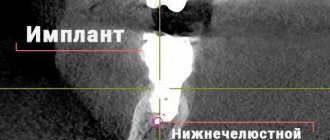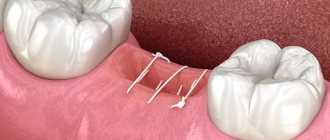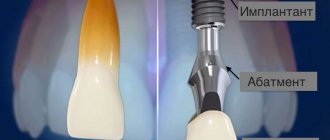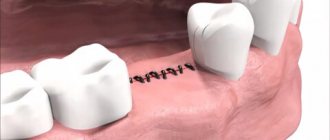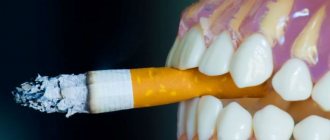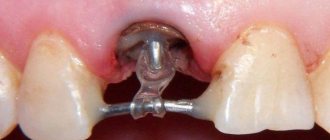Carrying out any surgical interventions in the area of the facial part of the skull, including dental procedures, is extremely dangerous due to the close location of important anatomical structures. When performing seemingly simple tasks during surgery, damage to atypically located nerves, vessels, and ducts of the salivary glands is possible, which leads to significant complications. Numbness after sinus lifting and bone grafting can appear at different stages of the operation and postoperative period; its causes can be very diverse and closely intertwined.
A little about the anatomy and course of the branches of the trigeminal nerve
The teeth of the upper and lower jaw are innervated by the branches of the trigeminal nerve, which provide all types of sensitivity directly to the teeth, skin and mucous membrane of the lips and cheeks. The lower jaw - by the mandibular nerve, the upper - by the alveolar branches of the maxillary nerve, forming the dental plexus.
The alveolar branches of the maxillary nerve pass along the wall of the maxillary sinus to the apexes of the roots of the upper teeth, where they form a nerve plexus responsible for the sensitivity of the upper teeth and gums. The mandibular nerve passes through the bone canal of the same name, innervating the lower teeth and gums, lower lip, and part of the cheek.
Characteristics of sinus lifting and bone grafting
Bone grafting in dentistry is designed to increase the volume of bone tissue to create suitable conditions for placing a dental implant. An increase in the volume of hard tissues can be carried out both through the use of one’s own bone material and with the use of synthetic substitutes. Bone grafting is performed on both the lower jaw and the upper jaw.
Sinus lifting is an operation performed exclusively on the upper jaw and, in essence, is a type of bone grafting. Its task is to raise the bottom of the maxillary sinus in order to increase the volume of bone mass. Additional bone material can be either your own or artificial. There are two ways to perform a sinus lift: open and closed. They differ in the complexity of execution and the ability to add different amounts of bone tissue.
Dental implant placement should not be confused with bone grafting or sinus lifting. These are two different operations, although they can be performed simultaneously. If there is initially a small amount of bone tissue, it may not be possible to place a dental implant immediately. Then, first, bone tissue is built up, and only a few months later, an artificial tooth is implanted.
Causes of numbness after surgery
It should be immediately mentioned that numbness associated with anesthesia will not be considered, since it is a normal reaction to the administration of the drug. Anesthesia can be maintained to one degree or another from several hours to a day, after which sensitivity returns in full and sometimes painful sensations of varying severity are observed. Also, a slight decrease in sensitivity may persist due to existing edema, which is a variant of the normal condition.
Severe loss of sensation occurs when the branches of the trigeminal nerve are damaged or compressed.
Anesthesia during surgery
Numbness prevents you from feeling pain during surgery. Achieved by administering anesthetic drugs. If sensitivity returns and the procedure has not yet come to an end, the drug is added to prolong the effect of local anesthesia.
In rare cases, a substance used for pain relief or improperly administered anesthesia can cause longer-term numbness - up to six months.
Problems in the lower jaw
Loss of sensitivity after bone grafting, like any other surgical interventions, is much more common in the lower jaw. This is due to the fact that during surgery, with an atypically high location of the mandibular canal or a small amount of bone tissue, nerve damage or compression may occur.
Nerve damage during surgery
Thanks to the widespread use of radiography and computed tomography, such a complication is now extremely rare. It may be associated with an atypical location of the mandibular canal, fragility of bone tissue, or medical error.
During the process of access, removal of tooth root debris, and formation of new bone tissue, the nerve may be damaged by the instrument or compressed by excessive amounts of new bone mass. In this case, after the end of anesthesia, numbness of the teeth anterior to the site of bone grafting, the lower lip, chin, and part of the cheek may persist.
Nerve compression due to implant displacement
If a dental implant changes its location due to injury, inflammation, or violation of medical instructions, compression of the mandibular nerve may occur. A similar situation can develop both in the first days and weeks after surgery, and after a long time.
With such a nerve trunk injury, extremely severe pain may initially be felt, and only then numbness may appear.
Nerve compression due to abnormal healing
After bone grafting, the slow process of new bone formation begins. Sometimes regenerative processes follow a pathological path, when newly formed tissues compress surrounding structures, blood vessels, and nerves.
This condition develops gradually, over 1-3 months after surgery. Numbness also does not appear immediately. Initially, it may be almost invisible or appear occasionally, passing after some time. Over time, numbness may increase or may remain at the same level.
Numbness during dental implantation
Incorrectly performed dental implantation is one of the most common factors leading to numbness of the front teeth. Sometimes the main reason is unsuccessful anesthesia, since during the injection process the needle may well damage the jaw nerve and lead to loss of its sensitivity.
The syndrome occurs as a result of erroneous determination of the length of the implant. In this case, after the procedure of its implantation, the nerve is either injured or pinched.
There are several stages of numbness, which can be caused by a dentist’s mistake during installation of implants.
Find out what to do if a piece of a tooth breaks off
At the stage of neuropraxia, only partial numbness is observed, which usually lasts several hours and disappears either on the day of surgery or the next morning.
At the stage of axonotmesis, symptoms persist for about a month and are accompanied by pain.
The most severe form is neurotmesis, in which numbness is accompanied by the appearance of a scar and disappears no earlier than two months after implantation.
All of these listed forms are not the norm, so the appearance of any stage of jaw numbness should be discussed with your doctor and undergo an additional course of treatment if necessary.
Problems in the upper jaw
Numbness after sinus lifting and bone grafting in the area of the upper teeth and gums is less common than in the lower jaw. This is due to the fact that the innervation of these structures is carried out by three groups of branches of the maxillary nerve, intertwined with each other and forming the dental nerve plexus. Such a structure is quite difficult to damage or completely disable.
The loss of sensitivity in the area of the upper lip and upper half of the cheek cannot in any way be associated with dental interventions due to the fact that completely different branches of the maxillary nerve go to them.
Damage to the alveolar branches or dental plexus
This complication can only develop in conjunction with penetration into the maxillary sinus during surgery, which should not occur if the operation is performed correctly.
Local, mild numbness develops. One or two teeth may be involved with incomplete loss of sensitivity.
Improper placement of the implant or complications in the postoperative period
Dislocation of the skeleton of a prosthetic tooth can occur due to injury, inflammatory processes, or neglect of the dentist’s recommendations. Diagnosis of this condition is not particularly difficult due to the obvious pathological state of the implant.
There may be loss of sensitivity due to chronic odontogenic sinusitis. The condition develops over a long period of time, occurs with severe symptoms of sinusitis, and numbness develops in extremely severe and advanced cases.
Numb gums - what does it mean?
When the gums become numb, unpleasant and tingling sensations appear in the soft tissue area. The manifestation of pathology is neurodental in nature or due to the action of external factors.
Local factors for the development of numbness:
- unsanitized oral cavity;
- chronic injuries;
- malocclusion;
- the effects of anesthesia after visiting the dentist.
These factors influence local immunity and change it. In this regard, there is an accumulation of microorganism metabolites, which contribute to the formation of oxygen radicals and oxidation products that irritate the receptors. This leads to numb gum syndrome, which does not pose a threat to human health and disappears immediately after the irritant is removed.
Paresthesia not caused by external causes is a pathology associated with disturbances in metabolic processes caused by changes in the central and peripheral nervous system, or disturbances in microcirculation and vascular tone.
In this case, numb gums are a symptom of a possible serious disorder in the functioning of the body.
Diagnostics
If partial or complete numbness occurs after sinus lifting and bone grafting, you should undergo a number of diagnostic procedures:
- Examination of the oral cavity by a dentist. Allows you to assess the general situation and in some cases even make a diagnosis immediately. Must go through first. If there is displacement of the implant or nerve injury during surgery, then further examination methods can be of a purely clarifying nature.
- Assessment of neurological status based on damaged branches of the trigeminal nerve. This task is more likely for a neurologist, rather than for a dentist. By testing reflexes and using special methods to determine sensitivity, it is possible to assess the presence/absence of nerve damage.
- X-ray or computed tomography. These examination methods make it possible to establish in detail and accurately the cause of loss of sensitivity. With the use of modern technologies, it becomes possible to calculate down to the millimeter the direction and degree of displacement of the installed structure, existing pathological foci of regeneration, and determine the presence of an inflammatory process both at the site of bone grafting and directly in the maxillary sinus.
Prevention
Since the cause is usually mechanical trauma, there are no special preventive methods to protect against the syndrome. However, to minimize the risks of this problem, you should keep an eye on the following things:
- qualifications of the treating dentist and prosthetist;
- availability of free time for proper rest;
- face protection from low temperatures.
Teeth numbness is an unpleasant syndrome that does not go away on its own. If you delay in contacting a doctor, the changes will develop into an irreversible stage. Moreover, paresthesia can act as a symptom of a serious illness. That is why it is worth taking this pathology seriously and starting to eliminate it in a timely manner.
Treatment options
If the nerve trunk, plexus or branches of the nerve are damaged or compressed, there are two ways to solve the problem.
The first is to leave everything as is, without performing surgery. Such a solution to the problem is acceptable in case of incomplete loss of sensitivity or a small area of focus, with the exception of cases with displacement of the denture. Compression of the nerve due to regenerative processes will stop progressing after a certain point, “frozen” in one place. Odontogenic sinusitis can be treated with medication using antibiotics.
The second method is to perform surgery. The operation is indicated for injuries during sinus lifting and bone grafting, displacement of dentures or bone mass, extensive or complete loss of sensation. During the operation, the cause of the numbness is eliminated and, if necessary, the damaged nerve is sutured. Restoration of sensitivity takes a long time, sometimes never returning to its original state.
Symptoms
The clinical picture of the pathology is associated with its type - primary or secondary.
Primary numbness occurs due to inflammation of the oral cavity or damage to nerve fibers.
If the gums are numb due to primary paresthesia, symptoms appear:
- burning;
- tingling;
- feeling of swollen gums;
- increased discomfort while eating;
- "crawling" feeling.
Other symptoms of numbness also include:
- exacerbation of symptoms by the end of the day;
- dry mouth;
- in some cases - weakening of taste buds.
Secondary numbness is characterized by:
- the presence of unpleasant sensations lasting from 2 days to several years;
- disappearance of tingling sensations when eating food;
- lack of effect from analgesics.
Secondary paresthesia occurs due to pathologies of organs and systems.
